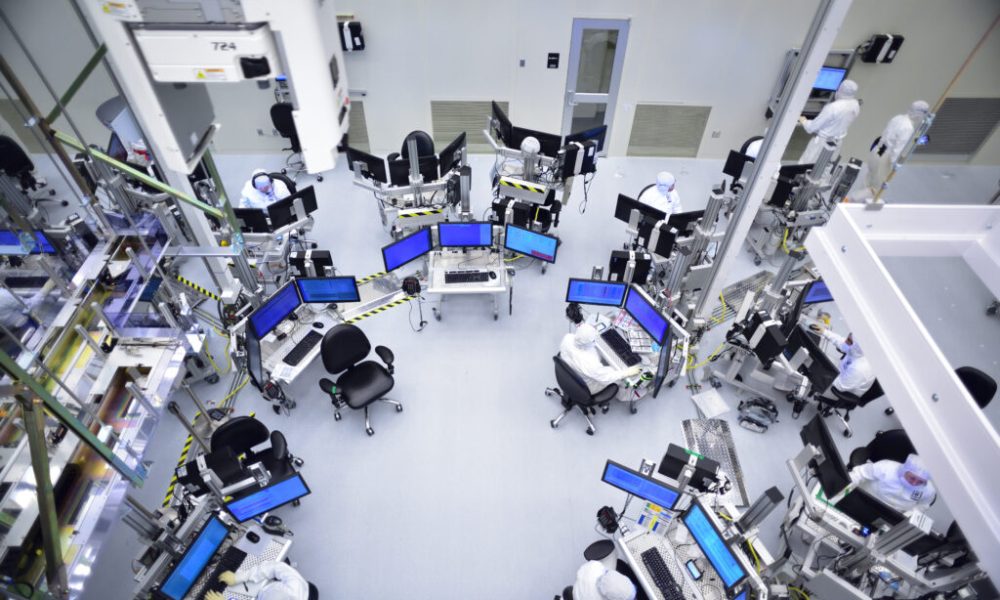Oregon is better positioned than many states to receive billions of dollars from the federal government to expand the semiconductor industry, but it still has work to do, according to legislative testimony this week.
The Legislature’s Joint Committee on Semiconductors, a 14-member group of Democratic and Republican senators and representatives that discussed the situation Wednesday has about a month to come up with a package of incentives to entice semiconductor manufacturers and suppliers to build or expand in Oregon. The U.S. Commerce Department will begin accepting applications in February for the $280 billion made available from last year’s CHIPS and Science Act.
U.S. Sen. Ron Wyden, who helped lead the task force, urged committee members to “be bold” as they worked on a plan to attract federal money to the state.
“I will work with you every step of the way and do whatever I can to help,” Wyden said. “Because when you’re successful, Oregon is going to be in a position to create thousands of good-paying jobs in semiconductors, manufacturing, technology, all the possible applications in our state using the CHIPS Act.”
Sen. Janeen Sollman, D-Hillsboro and co-chair of the committee, said other states are trying to take advantage of the federal funding, but they don’t have the foundation Oregon has. More than 40,000 Oregonians work in the semiconductor industry: Only California, with about 63,000 employees, and Texas, with close to 44,000, have more people in the industry. Oregon has nearly 15% of the nation’s semiconductor employment.
About half of Oregon’s semiconductor workforce, 21,000 people, work at Intel, which has a campus in Hillsboro. The majority of the state’s semiconductor companies have fewer than 10 employees.
Duncan Wyse, president of the Oregon Business Council, told the panel that the state needs to address five key issues to expand the semiconductor industry: a dearth of industrial land, stringent environmental regulations, incentives to make costs to build and operate in Oregon comparable with other states, expanded partnerships between universities or community colleges and the industry and a talented workforce.
The governor’s office and state agencies can handle environmental issues, such as expediting permit review, Wyse said. Former Gov. Kate Brown ordered those shifts last year.
The Legislature can address incentives, and it doesn’t need to do as much as states that don’t already have a foundation in semiconductors, Wyse said.
“This is a goldmine for state revenue, and other states have figured that out and they’re getting more aggressive on incentives,” Wyse said. “We don’t need to match every state, we have a lot of competitive advantages, but we do need to look at our incentives.”
Dan Malinaric, vice president of Fab 4 Operations at Arizona-based Microchip Technology Inc., said the company has 900 employees and 300 contractors at a site in Gresham. The company wants to expand in Gresham, he said, with plans to hire 250 employees in the next two years.
But a recent analysis the company commissioned found that it would cost 16% more to build a comparable facility in Oregon than in Arizona, Malinaric said. Some of those extra costs are unavoidable – Oregon has seismic construction standards that Arizona doesn’t have because Oregon’s at higher risk of earthquakes.
Higher labor costs in Oregon also contributed to the disparity, Malinaric said. He said more investment in community college and high school programs would also help the company expand. It has a partnership with Mount Hood Community College to offer students in its semiconductor and mechatronics programs part-time jobs and aid with tuition, books and fees.
“We’re in the process of working with work solutions to figure out how we can market this program to underserved portions of our community and high school students who are interested in STEM positions, but we don’t have enough students in the mechatronics programs,” Malinaric said.
Impact on the state
Lawmakers jokingly sparred over where in the state the industry should expand, with coastal Rep. David Gomberg, D-Otis, quipping that fish and chips belonged together. On a more serious note, Gomberg asked how growing the semiconductor industry, which is largely centered in Washington County, would help Oregonians throughout the state.
“The median family income in Washington County is 60% higher than it is in my district,” Gomberg said. “And I just don’t anticipate we’re going to really be making chips anywhere near the salty air of the coast.”
Wyse said a large semiconductor manufacturing plant likely won’t be located on the coast, but the smaller companies that supply components and pay well might choose to build throughout the state. Intel has suppliers in 15 of Oregon’s 37 counties.
People working in the industry may support other local businesses, Wyse said. And beyond that, tax revenue from the income taxes paid by high-earning semiconductor employees and the corporate income taxes paid by their employers can be used to invest in workforce development and other programs throughout the state.
Senate Minority Leader Tim Knopp, a Bend Republican and one of the committee’s vice chairs, said that makes the committee’s work the most important thing the Legislature will do this year.
“Most of our budget is income tax, the vast majority. So a higher-paying job, the more taxes they pay, the more investment you get in the people of Oregon,” Knopp said. “We need to think about this as investing in people and their education, investing in people and their health care, investing in people and their opportunity for housing.”
Oregon Capital Chronicle is part of States Newsroom, a network of news bureaus supported by grants and a coalition of donors as a 501c(3) public charity. Oregon Capital Chronicle maintains editorial independence. Contact [email protected]. Follow Oregon Capital Chronicle on Facebook and Twitter.

Julia Shumway is deputy editor of Oregon Capital Chronicle and has reported on government and politics in Iowa and Nebraska, spent time at the Bend Bulletin and most recently was a legislative reporter for the Arizona Capitol Times in Phoenix. An award-winning journalist, Julia most recently reported on the tangled efforts to audit the presidential results in Arizona.









